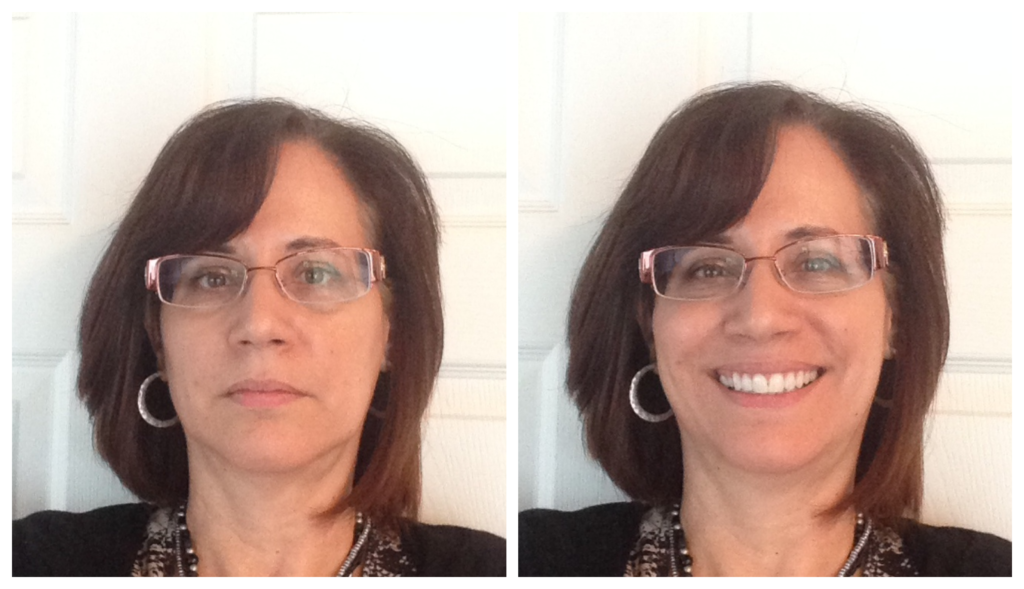Which person’s presentation would you rather attend?
Or, this person’s presentation?
In the top picture, I am displaying my neutral face. I am neither happy nor sad. But don’t I look a little sad, maybe even angry? I also look every one of my 51 years. Gravity is starting to give me a slightly saggy look (maybe loosing 32 pounds this year has something to do with that, too). The honest truth is that as we age, our neutral look doesn’t look so neutral, and it ages us.
But, in the bottom picture, with my smiling face, I’ve given myself a free face lift and a mood boost to anyone looking at me (not to mention a mood boost to myself!). When I took this picture my thought was that I was going to speak to you, my readers and the first message I wanted to get across was, “I like you. I really like you.”
Wouldn’t you agree that an expressive face (especially a smiling face) is more attractive than a neutral face?
Then, why do so many speakers lose their authentic personality and their facial expressions when they speak before an audience?
In a nutshell: because they are NOT being their authentic selves.
It’s all too easy to get so wrapped up in trying to not screw up that you can become self-conscious and restrained. I see it all the time. And, I’ve been guilty, too. This is often a problem for the most diligent of speakers–the ones who carefully plan, write and practice their speeches, trying to get just the perfect wording. And then, in front of an audience, they seem a little stiff.
Think about how you talk to a good friend when you are relaxed and talking about something that excites you, something you want to share. You smile and your face shows your emotions. You aren’t thinking about trying to be perfect or even saying things just so. You are focused on your message and the other person.
You might have faces like this:
The I-can’t-wait-to-tell-you-this face:
The you’ve-got-to-be-kidding-me face:
And, the joyful, laughing face:
So, how can you let your authentic self shine through when you speak?
Love your message. Be passionate. Use stories that create emotions within you and your audience. Love your message so much that you internalize it and don’t memorize it. Practice from key word notes and allow yourself to deviate from your so-carefully chosen phrases. What looks good on paper doesn’t always sound conversational (and it can be hard to remember).
Love your audience. Get to know your audience. Set up informational interviews with a few audience members well before you speak, if you don’t already know them. Talk to audience members before you speak. Think of your message as a gift to your audience. And, you, like a mom on Christmas day, can’t wait to give her children the gifts she so carefully chose, can’t wait to give your audience the gift of your message. It’s not about you. It’s about them. Give your audience the “I-really-like-you smile” before you even start. It will relax them and you!
Love yourself. Realize that we are hardest on ourselves. You don’t need to be perfect. Really, do you feel connected with the “perfect” speaker, the one who commands the stage, but doesn’t seem real? Don’t try to achieve perfection. You will fail. Instead strive for excellence.
I am careful not to confuse excellence with perfection. Excellence, I can reach for; perfection is God’s business. –Michael J. Fox
Video from my online course, No Fear Public Speaking






This is so true. Recently I’ve tried using a more positive expression when on webcam, too, and using good lighting, both of which make me look better!
Recently I reviewed a video from the Toastmasters website, and one of the clip’s most striking aspects was how warmly (and often) the speaker smiled. It made a huge difference to her likeability, and how receptive I was to the message. See what you think.
Craig–I read your video review–very comprehensive and interesting (I’m going to have to watch the Duarte webinar in full!).
Thanks,
Diane
Thanks Diane. (I thought the Duarte webinar had some excellent points, but was a little disappointing overall.)